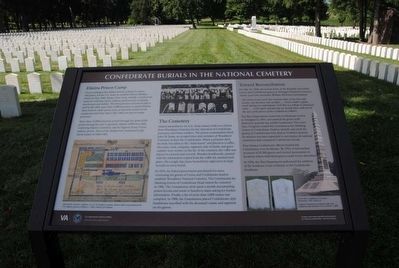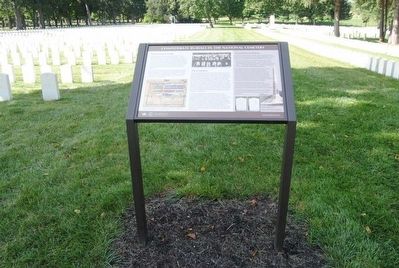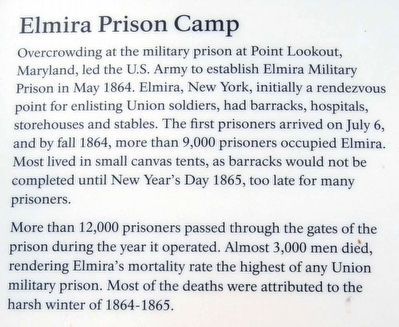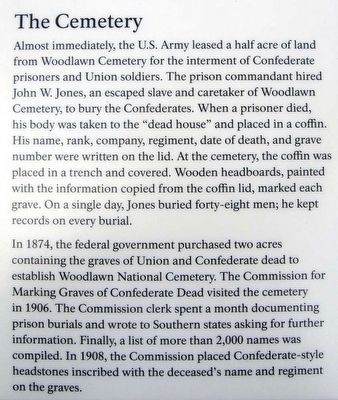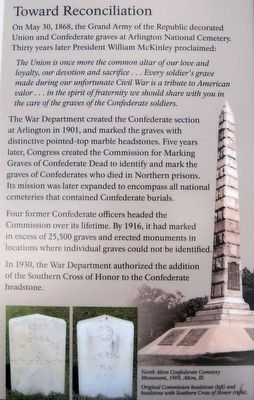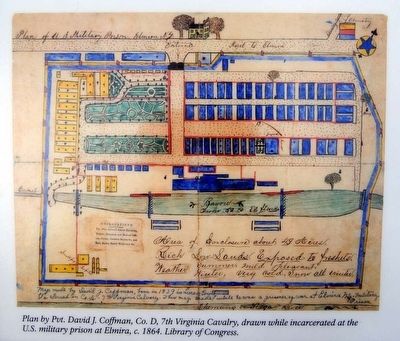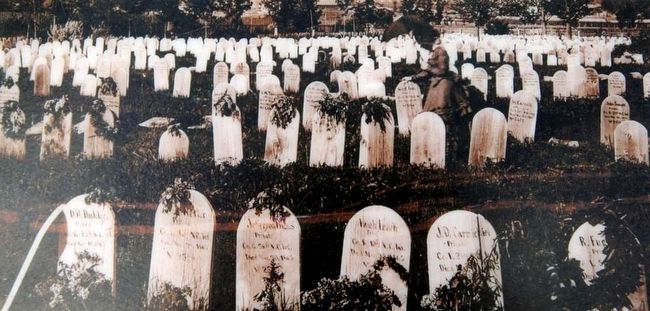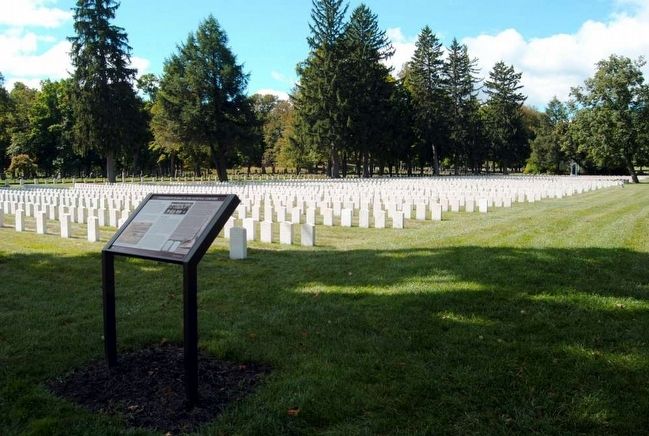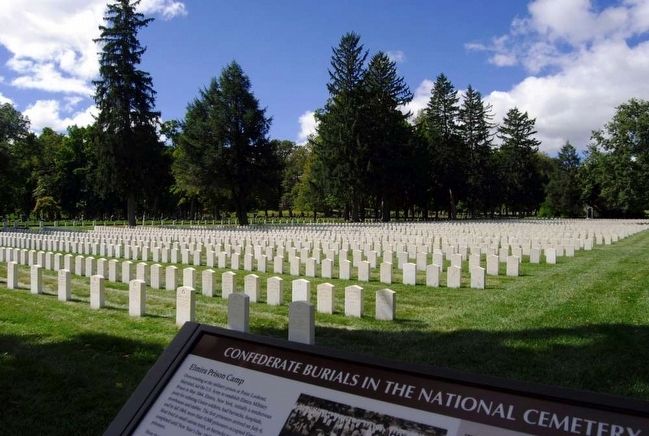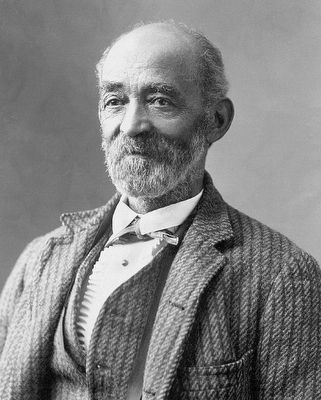Elmira in Chemung County, New York — The American Northeast (Mid-Atlantic)
Confederate Burials in the National Cemetery
Inscription.
Elmira Prison Camp
Overcrowding at the military prison at Point Lookout, Maryland, led the U.S. Army to establish Elmira Military Prison in May 1864. Elmira, New York, initially a rendezvous point for enlisting Union soldiers, had barracks, hospitals, storehouses and stables. The first prisoners arrived on July 6, and by fall 1864, more than 9,000 prisoners occupied Elmira. Most lived in small canvas tents, as barracks would not be completed until New Year's Day 1865, too late for many prisoners.
More than 12,000 prisoners passed through the gates of the prison during the year it operated. Almost 3,000 men died, rendering Elmira's mortality rate the highest of any Union military prison. Most of the deaths were attributed to the harsh winter of 1864-1865.
The Cemetery
Almost immediately, the U.S. Army leased a half acre of land from Woodlawn Cemetery for the internment of Confederate prisoners and Union soldiers. The prison commandant hired John W. Jones, an escaped slave and caretaker of Woodlawn Cemetery, to bury the Confederates. When a prisoner died, his body was taken to the "dead house" and placed in a coffin. His name, rank, company, regiment, date of death, and grave number were written on the lid. At the cemetery, the coffin was placed in a trench and covered. Wooden headboards, painted with the information copied from the coffin lid, marked each grave. On a single day, Jones buried forty-eight men; he kept records on every burial.
In 1874, the federal government purchased two acres containing the graves of Union and Confederate dead to establish Woodlawn National Cemetery. The Commission for Marking Graves of Confederate Dead visited the cemetery in 1906. The Commission clerk spent a month documenting prison burials and wrote to Southern states asking for further information. Finally, a list of more than 2,000 names was compiled. In 1908, the Commission placed Confederate-style headstones inscribed with the deceased's name and regiment on the graves.
Toward Reconciliation
On May 30, 1868, the Grand Army of the Republic decorated Union and Confederate graves at Arlington National Cemetery. Thirty years later President William McKinley proclaimed:
The Union is once more the common altar of our live and loyalty, our devotion and sacrifice...Every soldier's grave made during out unfortunate Civil War is a tribute to American valor...in the spirit of fraternity we should share with you in the care of the graves of the Confederate soldiers.
The War Department created the Confederate section at Arlington in 1901, and marked the graves with distinctive pointed-top marble headstones. Five years later,
Congress created the Commission for Marking Graves of Confederate Dead to identify and mark the graves of Confederates who died in Northern prisons. Its mission was later expanded to encompass all national cemeteries that contained Confederate burials.
Four former Confederate officers headed the Commission over its lifetime. By 1916, it had marked in excess of 25,000 graves and erected monuments in locations where individual groups could not be identified.
In 1930, the War Department authorized the addition of the Southern Cross of Honor to the Confederate headstone.
Erected by National Cemetery Administration, U.S. Department of Veterans Affairs.
Topics and series. This historical marker is listed in these topic lists: Cemeteries & Burial Sites • War, US Civil. In addition, it is included in the Former U.S. Presidents: #25 William McKinley, and the National Cemeteries series lists. A significant historical date for this entry is July 6, 1864.
Location. 42° 6.625′ N, 76° 49.583′ W. Marker is in Elmira, New York, in Chemung County. Marker can be reached from Walnut Street. Touch for map. Marker is at or near this postal address: 1200 Walnut Street, Elmira NY 14905, United States of America. Touch for directions.
Other nearby markers. At least 10 other markers are within walking distance of this marker. Shohola Railroad Accident Memorial (within shouting distance of this marker); Confederate Burials (within
shouting distance of this marker); Woodlawn National Cemetery (within shouting distance of this marker); A National Cemetery System (within shouting distance of this marker); Address by President Lincoln (about 400 feet away, measured in a direct line); Confederate Soldiers Memorial (about 400 feet away); John W. Jones (approx. 0.2 miles away); John W. Jones Museum (approx. 0.2 miles away); Colonel John Hendy (approx. ¼ mile away); Augustus W. Cowles (approx. 0.3 miles away). Touch for a list and map of all markers in Elmira.
Also see . . .
1. Woodlawn National Cemetery. VA National Cemetery Administration:
Woodlawn National Cemetery is located in Elmira, N.Y., in Chemung County. In 1861, the town was both a training and marshalling center for Union soldiers during the Civil War. As trainees were eventually assigned to military units and the barracks emptied, the federal government used the buildings as a prisoner-of-war camp. Originally known as Camp Rathbun, and designated Camp No. 3 during its existence from summer 1864 until the end of the war, this camp housed approximately 12,000
Confederate enlisted men. Approximately 3,000 men died here. (Submitted on October 30, 2015, by Brian Scott of Anderson, South Carolina.)
2. Woodlawn National Cemetery. National Park Service website entry:
Woodlawn National Cemetery in Elmira, New York, is located in a section of the city’s Woodlawn Cemetery. The U.S. government declared the section a national cemetery in 1877. The town of Elmira hosted a U.S. Army training and troop marshalling center at the beginning of the Civil War and later in the war, the military turned it into a Confederate prisoner of war camp. Overcrowding, inadequate shelter, and disease resulted in the deaths of nearly 3,000 prisoners, who were buried in Woodlawn Cemetery. Today, monuments stand on the cemetery’s grounds honoring the Confederate dead and victims from an 1864 railroad accident. (Submitted on October 30, 2015, by Brian Scott of Anderson, South Carolina.)
3. Woodlawn National Cemetery. Find A Grave website entry (Submitted on October 30, 2015, by Brian Scott of Anderson, South Carolina.)
4. John W. Jones. Wikipedia entry:
John W. Jones was born on June 21, 1817, on a plantation in Leesburg, Virginia, as a slave to the Ellzey family.[1] Jones died on December 26, 1900 and is buried in Woodlawn National Cemetery, not far from Mark Twain.[2] He was married to Rachel Jones (née Swails) in 1856, with whom he had three sons and one daughter.[3] On June 3, 1844, fearing he would be sold
to another plantation, as his owner grew old and near death, Jones and four others fled north. They survived a 300-mile trip and arrived in Elmira, New York in July 1844. (Submitted on October 30, 2015, by Brian Scott of Anderson, South Carolina.)
5. Woodlawn Cemetery and Woodlawn National Cemetery - National Archives. National Register of Historic Places documentation (Submitted on December 19, 2023, by Anton Schwarzmueller of Wilson, New York.)
Credits. This page was last revised on December 19, 2023. It was originally submitted on October 30, 2015, by Brian Scott of Anderson, South Carolina. This page has been viewed 873 times since then and 62 times this year. Photos: 1, 2, 3, 4, 5, 6, 7, 8, 9, 10. submitted on October 30, 2015, by Brian Scott of Anderson, South Carolina.
